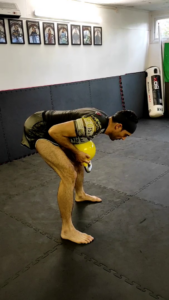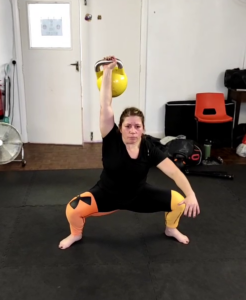Kettlebells have become a popular tool for fitness enthusiasts and athletes alike. With their unique shape and versatile design, kettlebells offer a challenging and effective way to build strength, power, and endurance. However, before you start swinging that kettlebell around, it’s important to learn the three basic movement patterns that will set the foundation for safe and effective kettlebell training: the hinge, squat, and full arm extension.
Whether you’re a beginner or an experienced lifter, mastering these movement patterns is crucial for proper kettlebell technique and injury prevention. In this blog post, we’ll take a closer look at each of these fundamental movements and provide you with the tips and cues you need to perform them with confidence and skill.
The hinge
The hinge movement pattern is essential for executing exercises like the kettlebell swing, deadlift, and single-leg deadlift. It involves a hip-dominant movement where the hips are pushed back, and the torso is hinged forward, creating a loaded stretch through the hamstrings and glutes.
To perform the hinge correctly, stand with your feet shoulder-width apart and hold the kettlebell with a neutral grip. Soften your knees and push your hips back, keeping your spine neutral and your chest lifted. Allow the kettlebell to naturally hang beneath you as you hinge forward, feeling a stretch through your hamstrings. Once you’ve reached your end range of motion, reverse the movement by driving your hips forward and standing tall, squeezing your glutes at the top.
Key cues for the hinge:
- Push your hips back, not down
- Maintain a neutral spine
- Keep your chest lifted
- Drive through your hips to return to the starting position

The squat
The squat movement pattern is essential for exercises like the goblet squat, front squat, and overhead squat. It involves a knee-dominant movement where the hips and knees are flexed to lower the body towards the ground while maintaining an upright torso and a stable core.
To perform the squat correctly, stand with your feet slightly wider than shoulder-width apart, toes slightly turned out, and hold the kettlebell close to your chest with the elbows tucked in. Initiate the movement by pushing your hips back and bending your knees, keeping your chest lifted and your weight in your heels. Lower yourself down until your thighs are parallel to the ground, then drive through your heels to stand back up tall.
Key cues for the squat:
- Push your hips back and bend your knees
- Keep your chest lifted and your core engaged
- Drive through your heels to stand back up
- Maintain an upright torso throughout the movement

To check the difference between the hinge and the squat, watch this video:
The full arm extension
The full arm extension movement pattern is essential for exercises like the kettlebell press, snatch, and Turkish get-up. It involves a vertical pressing or overhead movement where the arms are fully extended, and the shoulders are stabilized to support the weight of the kettlebell.
To perform the full arm extension correctly, start with the kettlebell in the rack position, with your elbow tucked in and the kettlebell resting against the outside of your forearm. Press the kettlebell overhead, fully extending your arm and locking out your elbow while keeping your shoulder down and stable. Lower the kettlebell back down with control, returning to the rack position before repeating the movement.
Key cues for the full arm extension:
- Keep your elbow tucked in and the kettlebell close to your body
- Fully extend your arm and lock out your elbow
- Keep your shoulder down and stable
- Lower the kettlebell with control and maintain stability throughout the movement
For a better explanation, watch Mark Wildman in action:
Putting it all together
Now that you understand the basics of the hinge, squat, and full arm extension, it’s time to put these movement patterns together in a full-body kettlebell workout. Start by warming up with 5-10 minutes of dynamic stretching and mobility exercises to prepare your body for the work ahead.
Next, choose a variety of kettlebell exercises that incorporate the hinge, squat, and full arm extension movement patterns, such as:
- Kettlebell swings
- Goblet squats
- Kettlebell presses
- Turkish get-ups
- Deadlifts
- Snatches
Perform each exercise for 3-5 sets of 8-12 repetitions, focusing on maintaining proper technique and engaging the muscles involved in each movement pattern. Rest for 60-90 seconds between sets, and be sure to cool down with some static stretching and foam rolling to aid in recovery and prevent muscle soreness.
Incorporate these fundamental kettlebell movement patterns into your regular training routine, and you’ll soon be reaping the benefits of improved strength, power, and endurance. Remember to start with a lighter weight and focus on mastering technique before progressing to heavier loads.
Conclusion
Learning the hinge, squat, and full arm extension movement patterns is crucial for safe and effective kettlebell training. By mastering these fundamental movements, you’ll not only reduce your risk of injury but also improve your overall strength, power, and athleticism. Whether you’re a beginner or an experienced lifter, the foundation of proper kettlebell technique starts with these three basic movement patterns. So, grab a kettlebell, practice these movements, and take your training to the next level!
